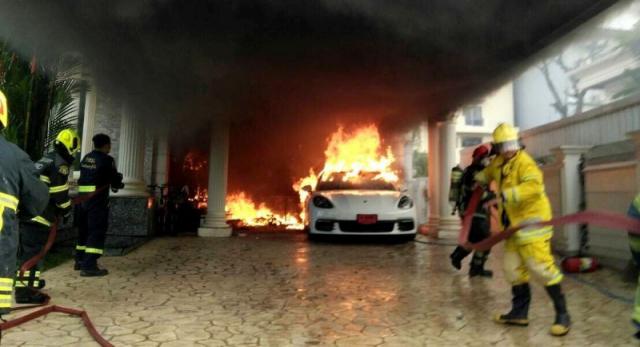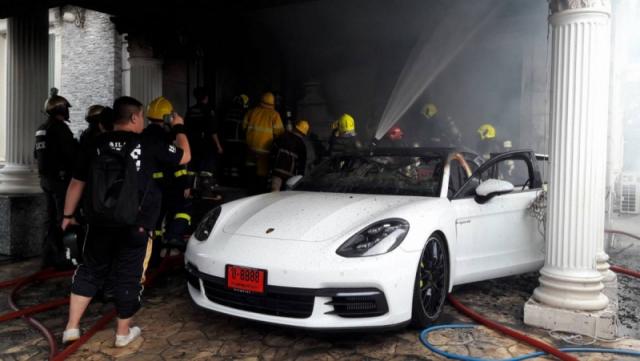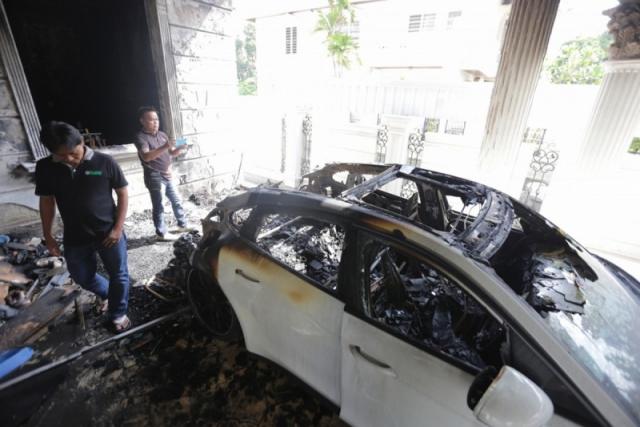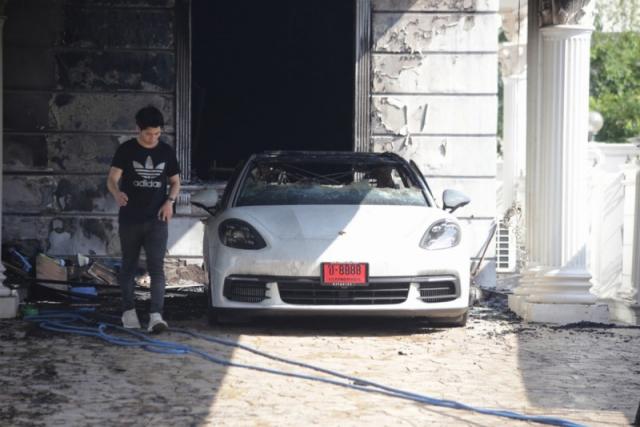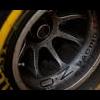Search the Community
Showing results for 'Porsche 911'.
-

Porsche showcases new turbocharged engine in facelifted 911
chitchatboy posted a blog entry in MyAutoBlog
Porsche reckons its new 3.0-litre turbocharged flat-six installed in its facelifted 911 Carrera and Carrera S has no downsides, according to the video posted below. While most buyers of the base 911 will probably not mind and in fact welcome the change, it marks the slow and likely start turbocharging taking over the whole 911 range. Not that its bad, given that both the turbocharged Carrera and the Carrera S get a 20bhp and 60Nm increase in power and torque as compared to its older, naturally-aspirated engines. Fuel economy improves too. So has turbocharging removed some of the flat-six's rapsy soundtrack? Watch the clip below and find out for yourself! https://www.youtube.com/watch?t=6&v=wx_YYgq0rvE -
$422k Porsche up in flames as battery charging goes wrong Plug-in hybrid electric vehicles (PHEV), which have been growing in popularity, suffered their latest high-profile casualty yesterday when a Bt10-million (S$422,000) Porsche Panamera caught fire while recharging its battery in Bangkok's Taling Chan district. The fire also damaged the owner's luxury home where the vehicle was being recharged overnight. AAS Auto Service Co, the authorised distributor of Porsche in Thailand, said the damaged car had not been purchased from the firm but from an independent importer. The firm said it was not sure if the buyer had been advised by the seller about how to properly install and use the charging system. The electrical cords, sockets and other equipment of the charging system of vehicles imported by independent firms may not match the specifications for use in Thailand, according to a company spokesperson. As the authorised distributor, the firm has engineers certified by Porsche of Germany to install the system and equipment for recharging the plug-in hybrid vehicles which are powered by both electricity and petrol, but they are required to be plugged in at home overnight to recharge the battery, he said. Police and firefighters were summoned at 6.30am yesterday even as the luxury sports car was already engulfed in fire with the flames reaching the nearby living room of the house. Homeowner Natthawut Kritaya-ayanont said the drawing room and home-theatre system were badly damaged. The cost of repairs were estimated at Bt6 million. He said his mother had bought the car last September. She had taken it out on Thursday evening for some errands and returned home at around 10pm. As per her routine, she plugged in the home battery-recharging kit and went to bed. Natthawut said he heard an explosion at 6am when the family was still in bed. They rushed downstairs to find the car ablaze and the fire spreading. Porsche encourages Panamera owners to frequently recharge the battery with the home kit because the car's electronic components use a lot of power. The car was insured, Natthawut said. Car specialist Pattanadesh Asasappakij, who also owns a Porsche plug-in hybrid vehicle, said several factors could have caused the fire. "We still don't know the details of the electrical system so it is difficult to pinpoint the exact cause," he said. However, Pattanadesh noted that if the vehicle had been purchased from the authorised importer - AAS Auto Service Co Ltd - they would have installed the charging box, which comes with a good level of safety systems. "Apart from the charging system in the car, we must also consider the home electrical system as well as the size of the cables," he said, adding that in his home, the charging box was separate from the house's main board. "I also use a larger diameter cable just to be sure. I've never had any problems, even when I've left the charging cable connected for days." Pattanadesh said the fire could affect public confidence in new technology like PHEVs, but not for long. "Thais respond to everything and this will be no different from news of smartphone batteries exploding. They'll be scared for a while before everything returns to normal," he said. http://www.asiaone.com/asia/422k-porsche-flames-battery-charging-goes-wrong?xtor=EREC-16-4[Emarsys_Newsletter]-20180319&extid=6934d0cfb7b252f1ae9f0dbddf5ff88ca8637e77
-
A very rare Porsche 959 Paris-Dakar race car from 1985 is set to be auctioned off by RM Sotheby on 27th October as part of the auction house’s 70th Anniversary Porsche sale in Atlanta. It is set to fetch around S$4 million to S$4.6 million. For those who wonder why the car can expected to fetch so much, there were only six units of the Porsche 959 Paris-Dakar built so. And with the 959 built for racing as a rally car for the Group B championship, it was only natural the 959 was entered in the Paris-Dakar race after FIA removed the Group B championship. The Paris-Dakar models featured the same adjustable suspension and all-wheel drive system of Porsche’s planned Group B rally car. It uses a 3.2-litre naturally-aspirated flat-six from a 911 Carrera instead of the twin-turbocharged flat-six from the road car. This example did not win the race in the year it was entered but a different 959 won the race the next year.
-
The Macan is the sixth model in Porsche's lineup, and will sit just below the Cayenne in the family hierarchy. Conceived to be the 'sports car' of its segment, the new Macan embodies the sporting DNA of the Stuttgart automaker. The base variant features a 2.0-litre four-cylinder engine - the smallest in Porsche's current lineup - and packs 237bhp. But at $218,888 (w/o COE), do you think the Macan 2.0 is a good buy?
- 239 replies
-
- porsche
- porsche macan
- (and 8 more)
-

Porsche 911 GT3 RS fights it out with other limited edition rivals
chitchatboy posted a blog entry in MyAutoBlog
According to Chris Harris, Porsche's 911 GT3 RS has created so much hype that buyers are willing to pay almost double its retail price to own one which gave Chris a thought. If these people are willing to pay up to £200k (S$428k) for a £131k (S$280k) car, would they be better off with a car that actually cost £200k in the first place? Two such options would be McLaren's 650S and Aston Martin's GT12. So is the GT3 RS worth in money as much as the other exotics? Watch and find out! https://www.youtube.com/watch?v=58j0Mmj41m0 -
Whenever Porsche comes out with a 911 that is designated a 'GT2' almost everyone gets nervous. The GT2 moniker is usually reserved for a high performance version of the 911 Turbo. It is lighter than the Turbo version as Porsche threw away the all wheel drive system and made it rear wheel drive. The 996 version of the GT2 became known as a 'widowmaker' as it channeled more than 500bhp from its rear mounted engine only to the rear tires. The recipe of the engine at the wrong place and too much power to the rear wheels made it even worse than the usual 911 type of scary, pendulum-like oversteering effect that happens when things go wrong. So what does Porsche do then?. Porsche has now come up with an 'RS' version of the already manic GT2; the Porsche 911 GT2 RS. The car pictured above has supposedly lapped the Nurburgring Nordschleife in 7minutes 18secounds and was recently previewed to dealers in Europe. It is 200kg lighter than the already lightweight GT2. It is even more powerful than the already legendary and ultimate (of its time) Porsche Carrera GT which only has 612ps. It does 100km/h from a standstill in 3.4 seconds, zero to 200km/h in under 10 seconds and a top speed of over 300km/h. At a stroke, Porsche has created the ultimate 911 Turbo. This is like the 911 GT3 RS but with '21' added on the scale of 10. The GT2 RS makes 620ps from its 3.6liter twin turbocharged engine. The whole thing runs through the rear axle which I believe must be aided by the PASM or Porsche Stability Management System. The RS also has a roll cage like the GT3 RS in place of its rear seats. But I have to say that in other words, they have created a car that may be potentially the scariest road going Porsche of them all. This car may reaffirm the 'widowmaker' nickname of the original GT2 and it will surely enter the annals of almost everyone's top 10 911s ever produced. The cost for owning one of these, limited to 500 units monster? It starts at 240,000Euros. All the Porsche I ever wanted was the GT3 RS. Now they've done it by moving the goalposts of 911 heaven again.
-
- Porsche
- Porsche 911
-
(and 3 more)
Tagged with:
-

Someone managed to fit a manual gearbox into a 911 GT3 RS
chitchatboy posted a blog entry in MyAutoBlog
Porsche offered its 911 GT3 RS without a manual gearbox due cost and marketing reasons but it didn't stop a owner from converting his car from the standard fit dual-clutch gearbox to a manual gearbox. As seen from the Rennlist forum via Carscoops, a Porsche purist and collector recently decided to take matters into his own hands and fitted a six-speed manual from the 911R to his GT3 RS. With nearly 1,500km on his car, he enlisted the help from BGB Motorsports and for the next seven to eight months, everything was planned and ready for the transplant. Together, they bought a 911R transmission from Suncoast Porsche Parts after it was added to the Porsche parts catalog. It cost around S$30k and was successful slotted in the RS a few weeks ago. While the car might not be as fast around the track as the factory model, we are sure the owner will have more fun driving his car hard. -
Stay tuned... Jaguar lines up J-Pace SUV to take fight to Porsche Cayenne https://www.autocar.co.uk/car-news/new-cars/jaguar-j-pace-to-fight-porsche-cayenne. J-Pace to use Range Rover running gear and powertrains, due 2021; electric-only new XJ on sale in 2019 Jaguar is working at top speed on an all-new £80,000-plus J-Pace SUV for 2021, designed to beat the Porsche Cayenne at its own game. The model will have a brand-new shape inspired by Jaguar design director Ian Callum and an obvious on-road bias, but it will draw on theRange Rover for much of its running gear. It will be the brand’s fourth eye-grabbing entry into the gigantic global SUV market in just five years. Jaguar stands on the edge of a highly profitable, much higher-volume future, based on rapidly rising sales of an SUV family that started with the F-Pace just two years ago and will probably account for two-thirds of its total sales in the early 2020s. Also prominent in this progress will be a quick increase in the number of electrified Jaguars – both hybrids and full EVs – some of which will draw on the hardware, software and design influences of the revolutionary I-Pace, just launched. The company, which promises at least one electrified version of every model by 2020, will keep its mix of performance-oriented saloons, SUVs and sports cars while accepting that burgeoning world demandfor soft-roaders is its real passport to higher sales and big profits. Nine new Jaguars to expect in the coming years The success of the 2016 F-Pace and the embryo success of the smaller, more affordable E-Pace are the main reasons for current improvements. However, company bosses are well aware that they need to continue producing upper- end models like the J-Pace to reinforce Jaguar’s image as the home of substantial, luxurious performance cars. Key models of the near to medium future are next year’s all-electric XJ limousine – which is being launched at that time to mark the 50th anniversary of Sir William Lyons’ seminal XJ original – and the bigger, super-luxury J-Pace. Jaguar’s volumes, decimated in the financial crash of 2008-2009, have been rebuilt rather laboriously to around 150,000-160,000 cars a year, while bullish Land Rover and Range Rover sales have lifted total Jaguar Land Rover (JLR) volume beyond 600,000. Although that total is impressive in some ways, Tata-JLR bosses at one time planned to reach 800,000 sales by now and still have their eyes on an annual group total exceeding one million. Jaguar’s SUV charge: In a sense, the F-Pace of 2016 was the beginning of the rest of Jaguar’s life. It has become the marque’s most successful model for decades, selling more than 70,000 copies last year, after a similar performance the previous year. There are strong indications that we’ll see a plug-in hybrid concept this year, drawing on know-how from the recent Range Rover and Range Rover Sport hybrids. A mid-life refresh is due next year, too, (perhaps the two will coincide) and a full replacement is already timed for late 2022, because this is one model Jaguar wouldn’t want to get wrong. Hopes are even higher for the recently launched, smaller E-Pace, whose BMW rival, the X1, posted sales of around 120,000 last year. In the UK alone, sales of all compact SUVs exceeded 170,000 last year, more than doubling in three years. Jaguar is rightly bullish about further expansion of the class. The one awkward point is that a generous slice of this volume was earned by the Range Rover Evoque, now six years old and still a major force in the market. The E-Pace’s success is certain to cause some sales cannibalisation. The I-Pace – Jaguar’s first electric car and launched at the Geneva motor show last week – has already won big plaudits for looks, proportions and the boldness of its concept. It is being made in Graz, Austria,by Magna Steyr at greater cost than in one of Jaguar’s own plants, but the company regards it as proof of its credentials as a leading user of new technology and is happy to invest. The best guidance on I-Pace volumes is that it will be “somewhere either side of F-Type”, which sounds like 10,000-15,000 cars a year, although company insiders are honestly unsure how it will go. Given the combined expense of the model’s new, stand-alone electric architecture and Magna’s manufacturing, this looks like being Jaguar’s least profitable model, although JLR CEO Ralf Speth insists it’ll be a money-maker “at the anticipated volumes”. Some say it could eventually be made in China, where manufacturing electric cars has recently become easier. The fourth SUV in Jaguar’s frame, the J-Pace, will be a sleek and luxurious all- aluminium model for the early 2020s. It’s likely to use a developed version of the Range Rover aluminium architecture, although it will be longer, lower, probably more spacious in the rear and much more on-road biased. It will employ Range Rover running gear and powertrains, and plug into a rising demand for super-luxury SUVs. Jaguar bosses will expect it to sell especially well in China, where well-heeled owners are chauffeur-driven. JAG’S SALOON CHALLENGE Jaguar needs saloons. They’ve been a backbone since the heyday of company founder Lyons but not enough people are buying them now. Last year, the compact XE, launched in 2015 to fight the BMW 3 Series and Audi A4, made barely 19,000 sales in Europe (around 25,000 in the previous year) against 170,000 for the leading Mercedes C-Class. The mid-sized XF, recently refreshed and with theSportbrake (estate) to help, does little better. Replacements are nonetheless planned for both cars in the early 2020s, mostly because special long-wheelbase versions of both have recently gone on sale in China and Jaguar is prepared to bet the resultant volume will make them viable. Big Jaguar saloon news is an electric XJ (as scooped by Autocar earlier this year), due to be shown this year and on sale in 2019. The car is believed to be a second application for the twin-electric-motor architecture introduced with the I-Pace, with all the benefits in smoothness and cabin space we’ve already seen. Jaguar wants the new XJ to be seen as revolutionary – as several of its predecessors were in their time – in a category diminished by the rising success of luxurious SUVs. JAG’S SPORTS CAR DECISION Jaguar faces potentially agonising decisions over sports cars. Should it drop them or give them more prominence? There are strong arguments for both courses, and Jaguar bosses are trying to decide the correct direction. Even before Tata bought JLR in 2008, it was clear there was going to be a brand-new Jaguar sports car. Ratan Tata, with fond memories of XK120s, was in favour from the beginning. The result was the 2013 F-Type convertible, which looked terrific although industry pundits have since criticised its price structure, the time it took JLR to add coupé (2014) and the lack of a small-engined version until 2017. Sales run at currently about 10,000 a year. The argument in favour of sports cars goes thus: Jaguar needs its image builder, just as Porsche (which still calls itself a sports car company) uses its minority 911 and 718 models to create an image for its SUVs and saloons. The F-Type should be raced, replaced and enhanced to add lustre to the brand. These arguments work in favour of a Jaguar XK coupé, another candidate for electric I-Pace and XJ architecture that could be priced just under the Bentley Continental GT. The anti-sports-car argument is that the F-Type is a modest earner, as all sporty cars now are. Its structure is expensive because it shares little with other production models. It doesn’t sell well in China, and even US sales run at about only 4000 units a year. The good news is that Jaguar now seems to have its model building blocks in place for the next few years, and they are starting to be effective. Since the F-Pace, Jaguar has started earning solid profits, with more and better in prospect from the E-Pace. The company’s managers can now give more concentration to image enhancers (like the I-Pace, XJ, J-Pace and possibly XK) it has always needed to maintain a special place in the world.
-
Hi all, I seldom post a lot and am currently looking to change my ride. I'd like to seek opinions from bros and automotive aficionados here on the above mentioned 3 models of SUV. I know all 3 are rather different in terms of branding or engine power or even comfort levels, but due to my limited knowledge on the available SUVs in this price range 300k+/-, these are the 3 that I can think of. I'm torn between these 3 for my next purchase and would like to find out more the pros and cons of the above 3. Am currently driving an Audi so thinking of changing to something fresh too. Would like to seek some opinions and reviews from bros here especially those who own the above 3 makes to share a little more into it. And also to find out which would be a better buy. Thanks in advance, and looking forward to your reviews and advise, cheers!
-
Hard to believe that time flies so fast. The one good news is they finally nailed Osama. But who "won" and who "lost" is still hard to say.
- 26 replies
-
- 10th
- Anniversary
-
(and 1 more)
Tagged with:
-
http://www.mycarforum.com/index.php?autoco...mp;product=4361 Even the oil filter element is so expensive!! Wow!! I wonder how much does a Porsche bolt or nut cost?
-
Porsche Design has launched its latest watch, the 1919 Daytimer 70Y Sports Car Limited Edition. It is meant to celebrate Porsche's anniversary. Using design elements inspired by the Porsche 356 and its dashboard instruments, the timepiece features a 42mm titanium case, which is coated in a matte-black titanium carbine finish and is water-resistant to 10 atmospheres. It also has a Swiss automatic movement with a 38-hour power reserve. With only 1948 units available worldwide (with reference to the year in which the company was founded), the watch will cost you around S$4,600 or so. It is available through a network of 130 Porsche Design stores around the world.
-

Porsche let's Chris Harris have a go in the 919 Hybrid
chitchatboy posted a blog entry in MyAutoBlog
Just before the Le Mans-winning Porsche 919 Hybrid goes into full retirement at the company’s museum, Chris Harris has a go in the car. With a total of six world championship titles sealed in total between 2015 and 2017, the 919 Hybrid has proved itself in terms of engineering and design in the racing world. With lots of downforce and a very clever 900bhp-plus hybrid powertrain, the 919 Hybrid is very effective car that tries to make it as easy as possible for the driver to consistently do fast lap times. Watch the video and see for yourself why Harris says that this is the first car he has driven that feels like its thinking its way around the circuit.-
- porsche
- chris harris
-
(and 1 more)
Tagged with:
-
http://www.worldcarfans.com/110122230147/p...worth-the-price
-

Used 911 R selling nearly seven times more than retail price
chitchatboy posted a blog entry in MyAutoBlog
Prices of the Porsche 911 R have rocketed so high that used examples are selling for up to seven times the car's original list price as reported by Autocar. When it went for sale in the U.K, it was retailing at around S$240,000 five months ago but since then, the publication has seen ads on the used market listing the special edition 911 for around S$1.8 million. Limited in supply, the driver-focused 991 sold out before the vehicle's global premiere. Demand for it was high as the vehicle was also considered to be the last of its breed, running a naturally-aspirated six-cylinder engine that is paired with a six-speed manual transmission. However, with the launch of the facelifted 991.2 GT3 that will have a manual gearbox option coming soon, the 911 R might lose its speciality unless Porsche decides to turbocharge the 991.2 GT3, leaving the 911 R as the last naturally-aspirated hardcore 911 with a stick shift. -
Mercedes-Benz reckons its new AMG GT is better than Porsche's 911 and comes up with a creative ad. In this ad, a kid is seen sleeping and having a good dream about his favourite sports car, the 911. All of a sudden, he feels frightened as something threatens to take over his dream car... https://www.youtube.com/watch?v=745ApnhDp4s I must say the aggressive advertising in this short ad plus the 'batman' soundtrack made quite a good impact!
-

Porsche commemorates 50th anniversary of the 911 with a special edition
SYF77 posted a blog entry in MyAutoBlog
The original 911 was revealed to press and public at the 1963 Frankfurt Motor Show as the 901. 50 years have since passed. To commemorate its golden anniversary, Porsche has created a limited edition 911 Carrera S and only 1,963 units will be built. Set for a world premiere at the Frankfurt Motor Show in September, the '911 50' will be available in two unique colors - the darker Graphite Grey and a lighter Geyser Grey metallic. The limited edition coupe is 44mm broader across the rear wheel arches, a feature typically reserved for AWD Carrera 4 models. Other exterior updates include a '911 50' badge on the rear lid, chromed window frames, SportDesign side mirrors and new 20-inch alloy wheels. On the inside, '911 50' logos can be found on the rev counter, headrests and door sill plates. There are styling touches reminiscent of the original 911 such as green labelling on the instruments with white pointer needles and silver caps on the instrument pivot pins. The fabric pattern on the center section of the leather sports seats seemed like a blast from the 1960s 'Pepita' tartan design. Powered by a 400bhp 3.8-litre flat-six engine, the '911 50' edition with PDK transmission sprints from 0 to 100km/h in 4.3 seconds before reaching a top speed of 298km/h. The coupe is equipped with Porsche Active Suspension Management (PASM) to compensate for the wider rear body and Porsche Torque Vectoring (PTV) with rear limited slip differential.-
- super cars
- other news
- (and 8 more)
-
Following in the footsteps of the 911 Carrera T, Porsche is likely to introduce the 718 Cayman in T guise, allowing buyers to experience a more focused driving experience. As reported by Auto Express, the coupe will resort to some weight saving measures including using thinner glass and lighter sports seats. Buyers could also opt remove the infotainment system for further weight savings, bringing the total shaved weight to around 20kg. Elsewhere, the car is set to gain a sports exhaust system, 20-inch alloy wheels, a lower ride height and Sport Chrono pack as standard. With around 360bhp, the car will be positioned between the Cayman S and GTS as it is 10bhp more than the Cayman S and 5 bhp less than the GTS.
-

The 2012 Porsche 911 Carrera S laps the Nurburgring with amazing results
Rigval posted a blog entry in MyAutoBlog
It seems the 2012 Porsche 911 Carrera S, one up from the base 911 Carrera model, has recorded a Nurburgring lap time of 7 minutes and 40 seconds. Nothing to actually shout about actually as you may know of cars that lap the 'Green Hell' faster than that. But the amazing thing about this figure is that this slightly better than the basic model 911 actually lapped the Nurburgring as fast as the 997 Porsche 911 GT3, the previous generation's Porsche 911 track day special. This is amazing indeed. This piece of news was brought about during a GoAuto.co.au interview with the Porsche 911 Product Director Mr. August Achleitner. The 2012 (surprisingly numbered Type 991) Porsche 911 Carrera S is powered by a 3.8-liter unit with an output of 400 PS (294 kW / 394 hp). The 0 to 100 km/h sprint takes just 4.3 seconds (4.1 with the Sport Plus function in the optional Sport Chrono package) and top speed is 302 km/h (188 mph). The 997 911 GT3 made 415bhp from a 3.6liter flat 6. So even with that firmer race car suspension and more focused demeanor overall, the newer more civilized car somehow manages to clock a faster lap time. This clearly shows that there is still much progress and magic that can be made through chassis tuning. I can't wait to see how the new 911 GT3 will perform. - A 997 Porsche 911 GT3-
- porsche
- 2012 porsche
- (and 8 more)
-
Porsche will be ceasing production of vehicles equipped with diesel engines as sales remain relatively small. According to Autocar, Porsche decided on this when it was considering on whether to offer a new Cayenne Diesel. It has also then taken the chance to stop offering the Macan S Diesel and Panamera 4S Diesel. In the article, a Porsche spokesperson said the move echo the "cultural shift" to more eco-friendly vehicles such as the its plug-in hybrid models and the electric Mission E. Unofficially, the implementation of the new Worldwide Harmonized Light Vehicles Test Procedure (WLTP) that replaces the New European Driving Cycle (NEDC) in Europe also meant that its engines needed upgrading to comply with the new regulations, which further cement the diesel's fate. Meanwhile, sales for the Macan diesel made up a "small portion" of overall Macan sales while the Panamera diesel only accounted for about 15% of overall Panamera sales. 27 February 2018 Update: Porsche Singapore has informed us that the upcoming Cayenne Diesel will still be available for sale in time to come.
-
With the derestricted 919 Evo that is based on the three-time Le Mans-winning 919 Hybrid, Porsche broke the Spa-Francorchamps lap record past April. However, that record didn't last long as three drivers lapped the Francorchamps circuit during this past weekend’s Belgian Grand Prix faster than the 919 Evo. According Motorsport.com, Ferrari's Sebastian Vettel, who clocked the fastest race lap at 1:41.501 managed to beat the Porsche's 1:41.770 lap record. Kimi Raikkonen and Mercedes-AMG's Lewis Hamilton also managed to go faster than the 919 Evo over the weekend. While the 919 Evo's lap record at Francorchamps circuit was short-lived, its record at the Nurburgring will likely stand for much longer as Formula 1 cars don't test nor race there.
-
A Proton has been caught on someone's dashcam driving recklessly and crashing into a Porsche GT3 RS in Malaysia. The accident was said to have happened in Kuala Lumpur a couple of days ago along one of KL's major roads. As one can see from the video, the driver to the Proton Perdana was speeding and wanted to overtake the Porsche. However, the Proton driver overreacted to the movements of another car and lost control of his car as he hit the brakes. To make matters worse, the driver of the proton is believed to not have a driving license nor insurance coverage too. https://www.facebook.com/569034886816281/videos/572982989754804/
-
Porsche has released a Bluetooth speaker that might tempt the Porsche enthusiast. Costing 499 euros (S$783), their speaker system replicates the 911 GT3’s rear tail pipes and merges it with a bespoke aluminium housing. The pipes itself are built using from high-quality aluminium. Weighing 3.3kg, this is no lightweight poor quality speaker and Porsche says that its sound signature is bigger than you expect from such a small speaker. Battery life is rated at 24 hours and max output is 60 watts. It is set to go on sale in October at Porsche Design stores.
-
Stay sharp, Ferrari, McLaren and Lamborghini: group tests are potentially going to get a whole lot more interesting in 2019, following the launch of new Porsche 960. Yes, it looks like Porsche is still working on a new mid-engined supercar that will rival the likes of the 488 GTB, 650S and Huracan. The long-overdue ‘960’, which is expected to cost around £200,000, will fill the blank in Porsche’s line-up between the 911 Turbo S and the flagship 918 Spyder. It had all been quiet on the 960 front until partway through last year, when Porsche quietly applied for – and was granted, in September 2015 – the ‘960’ trademark. One product the name was earmarked for was a car, suggesting that the long-mooted project was slowly becoming a reality. When recently queried about the registration, Porsche initially rolled out the response you might expect: ‘We won’t comment on future product. We’re just looking to preserve the nameplate identity and combinations that we don’t have, and to avoid going through the labour of proving a later claim based on our traditions.’ However, the spokesperson added the following: ‘There’s not been much on the topic of new models but, if you look, there are blank spots in our range – and you have to look at what the competition is doing and keep these things in mind. ‘Pragmatically, with our production cycle running as it is, we know where we are in the current model cycles – and there’s a lot to do at the moment. We’re very busy.’ The suggested delay in the 960 project correlates with our previous information, which indicated that the mid-engined Porsche had been shunted back to 2019. Reputedly, the next-gen 911 – so far dubbed the 992 – will arrive before the new supercar, at some point in early 2018. It’s likely, then, that we won’t hear anything more official until at least next year. Previously, production of the 960 was mooted to being in February 2017 at the company's Zuffenhausen-based plant. Production estimates range from 3000-4000 a year, over the course of six years – like the life cycle of the 911.
-
Porsche has created a video explaining why some of its cars are producing brake squeal when driving in normal conditions. While there are no official word on why they produced such a video, it is safe to guess that some of their customers have complained that they are experiencing such a 'problem' and Porsche wants to assure them that it is not an issue. We don't blame the customers though as it is ingrained in every driver’s mind after their first few years behind the wheel of a car that once their brakes screech, it's time to get them sorted out. So to get such squealing noises when their cars are new can be abit annoying considering how much Porsches cost. For those who want to know why high-performance brakes squeal when coming to a stop at low speeds, watch the video below and let the gurus at Porsche explain. https://www.youtube.com/watch?time_continue=215&v=fUNHb9O52WQ


